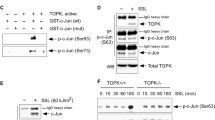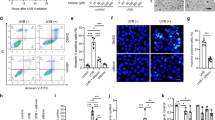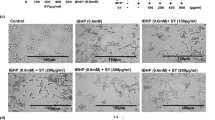Abstract
[6]-Gingerol, a pungent ingredient of ginger (Zingiber officinale Roscoe, Zingiberaceae), has a wide array of pharmacologic effects. The present study was aimed at unraveling the molecular mechanisms underlying previously reported antitumor promoting effects of [6]-gingerol in mouse skin in vivo. One of the well-recognized molecular targets for chemoprevention is cyclooxygenase-2 (COX-2) that is abnormally upregulated in many premalignant and malignant tissues and cells. In our present study, topical application of [6]-gingerol inhibited COX-2 expression in mouse skin stimulated with a prototype tumor promoter 12-O-tetradecanoylphorbol-13-acetate (TPA). Since the transcription factor nuclear factor-kappaB (NF-κB) is known to regulate COX-2 induction, we attempted to determine the effect of [6]-gingerol on TPA-induced activation of NF-κB. Pretreatment with [6]-gingerol resulted in a decrease in both TPA-induced DNA binding and transcriptional activities of NF-κB through suppression of IκBα degradation and p65 nuclear translocation. Phosphorylation of both IκBα and p65 was substantially blocked by [6]-gingerol. In addition, [6]-gingerol inhibited TPA-stimulated interaction of phospho-p65-(Ser-536) with cAMP response element binding protein-binding protein, a transcriptional coactivator of NF-κB. Moreover, [6]-gingerol prevented TPA-induced phosphorylation and catalytic activity of p38 mitogen-activated protein (MAP) kinase that regulates COX-2 expression in mouse skin. The p38 MAP kinase inhibitor SB203580 attenuated NF-κB activation and subsequent COX-2 induction in TPA-treated mouse skin. Taken together, our data suggest that [6]-gingerol inhibits TPA-induced COX-2 expression in mouse skin in vivo by blocking the p38 MAP kinase-NF-κB signaling pathway.
This is a preview of subscription content, access via your institution
Access options
Subscribe to this journal
Receive 50 print issues and online access
$259.00 per year
only $5.18 per issue
Buy this article
- Purchase on Springer Link
- Instant access to full article PDF
Prices may be subject to local taxes which are calculated during checkout






Similar content being viewed by others
References
Aggarwal BB . (2004). Cancer Cell, 6, 203–208.
Asano TK and McLeod RS . (2004). Dis. Colon Rectum, 47, 665–673.
Baldwin Jr AS . (1996). Annu. Rev. Immunol., 14, 649–683.
Balkwill F and Coussens LM . (2004). Nature, 431, 405–406.
Bhat NR, Feinstein DL, Shen Q and Bhat AN . (2002). J. Biol. Chem., 277, 29584–29592.
Bird TA, Schooley K, Dower SK, Hagen H and Virca GD . (1997). J. Biol. Chem., 272, 32606–32612.
Bode AM and Dong Z . (2000). Lancet Oncol., 1, 181–188.
Bode AM and Dong Z . (2004). Mutat. Res., 555, 33–51.
Bode AM, Ma WY, Surh Y-J and Dong Z . (2001). Cancer Res., 61, 850–853.
Bonnard M, Mirtsos C, Suzuki S, Graham K, Huang J, Ng M, Itie A, Wakeham A, Shahinian A, Henzel WJ, Elia AJ, Shillinglaw W, Mak TW, Cao Z and Yeh WC . (2000). EMBO J., 19, 4976–4985.
Cao Y and Prescott SM . (2002). J. Cell Physiol., 190, 279–286.
Chen N, Nomura M, She QB, Ma WY, Bode AM, Wang L, Flavell RA and Dong Z . (2001). Cancer Res., 61, 3908–3912.
Chun K-S, Keum Y-S, Han S-S, Song Y-S, Kim S-H and Surh Y-J . (2003). Carcinogenesis, 24, 1515–1524.
Chun K-S, Kim S-H, Song Y-S and Surh Y-J . (2004). Carcinogenesis, 25, 713–722.
Chun K-S and Surh Y-J . (2004). Biochem. Pharmacol., 68, 1089–1100.
Clevers H . (2004). Cell, 118, 671–674.
Gerritsen ME, Williams AJ, Neish AS, Moore S, Shi Y and Collins T . (1997). Proc. Natl. Acad. Sci. USA, 94, 2927–2932.
Ghosh S and Karin M . (2002). Cell, 109, S81–S96.
Grab LT, Kearns MW, Morris AJ and Daniel LW . (2004). Biochim. Biophys. Acta, 1636, 29–39.
Greten FR and Karin M . (2004). Cancer Lett., 206, 193–199.
Gupta S, Adhami VM, Subbarayan M, MacLennan GT, Lewin JS, Hafeli UO, Fu P and Mukhtar H . (2004). Cancer Res., 64, 3334–3343.
Harnish DC, Scicchitano MS, Adelman SJ, Lyttle CR and Karathanasis SK . (2000). Endocrinology, 141, 3403–3411.
Hoeflich KP, Luo J, Rubie EA, Tsao MS, Jin O and Woodgett JR . (2000). Nature, 406, 86–90.
Huang C, Li J, Ma WY and Dong Z . (1999). J. Biol. Chem., 274, 29672–29676.
Imhof A and Wolffe AP . (1998). Curr. Biol., 8, R422–R424.
Jiang X, Takahashi N, Ando K, Otsuka T, Tetsuka T and Okamoto T . (2003). Biochem. Biophys. Res. Commun., 301, 583–590.
Karin M . (1999). Oncogene, 18, 6867–6874.
Karin M and Delhase M . (1998). Proc. Natl. Acad. Sci. USA, 95, 9067–9069.
Kismet K, Akay MT, Abbasoglu O and Ercan A . (2004). Cancer Detect. Prev., 28, 127–142.
Kundu JK, Na H-K, Chun K-S, Kim Y-K, Lee S-J, Lee S-S, Lee O-S, Sim Y-C and Surh Y-J . (2003). J. Nutr., 133, 3805S–3810S.
Kuo MH and Allis CD . (1998). Bioessays, 20, 615–626.
Lee MW, Kim JH, Jeong DW, Ahn KH, Toh SH and Surh YJ . (2000). Biol. Pharm. Bull., 23, 517–518.
Liao CH, Sang S, Liang YC, Ho CT and Lin JK . (2004). Mol. Carcinog., 41, 140–149.
Lim JW, Kim H and Kim KH . (2001). Lab. Invest., 81, 349–360.
Madrid LV, Mayo MW, Reuther JY and Baldwin Jr AS . (2001). J. Biol. Chem., 276, 18934–18940.
May MJ and Ghosh S . (1997). Semin. Cancer Biol., 8, 63–73.
Mohan S and Epstein JB . (2003). Oral Oncol., 39, 537–546.
Muller-Decker K, Neufang G, Berger I, Neumann M, Marks F and Furstenberger G . (2002). Proc. Natl. Acad. Sci. USA, 99, 12483–12488.
Nakao S, Ogata Y, Shimizu-Sasaki E, Yamazaki M, Furuyama S and Sugiya H . (2000). Mol. Cell Biochem., 209, 113–118.
Newall CA, Anderson LA and Phillipson JD . (1996). Herbal Medicines: A Guide For Health-Care Professionals Vol. 4. Pharmaceutical Press: London, pp. 296.
Nomura M, Ma W, Chen N, Bode AM and Dong Z . (2000). Carcinogenesis, 21, 1885–1890.
Park K-K, Chun K-S, Lee J-M, Lee S-S and Surh Y-J . (1998). Cancer Lett., 129, 139–144.
Pikarsky E, Porat RM, Stein I, Abramovitch R, Amit S, Kasem S, Gutkovich-Pyest E, Urieli-Shoval S, Galun E and Ben-Neriah Y . (2004). Nature, 431, 461–466.
Saccani S, Pantano S and Natoli G . (2002). Nat. Immunol., 3, 69–75.
Sakurai H, Chiba H, Miyoshi H, Sugita T and Toriumi W . (1999). J. Biol. Chem., 274, 30353–30356.
Sizemore N, Lerner N, Dombrowski N, Sakurai H and Stark GR . (2002). J. Biol. Chem., 277, 3863–3869.
Sizemore N, Leung S and Stark GR . (1999). Mol. Cell. Biol., 19, 4798–4805.
Subbaramaiah K and Dannenberg AJ . (2003). Trends Pharmacol. Sci., 24, 96–102.
Surh Y-J . (1999). Mutat. Res., 428, 305–327.
Surh Y-J . (2002). Food Chem. Toxicol., 40, 1091–1097.
Surh Y-J . (2003). Nat. Rev. Cancer, 3, 768–780.
Surh Y-J, Chun K-S, Cha H-H, Han S-S, Keum Y-S, Park K-K and Lee S-S . (2001). Mutat. Res., 480–481, 243–268.
Takahashi N, Tetsuka T, Uranishi H and Okamoto T . (2002). Eur. J. Biochem., 269, 4559–4565.
Tiano HF, Loftin CD, Akunda J, Lee CA, Spalding J, Sessoms A, Dunson DB, Rogan EG, Morham SG, Smart RC and Langenbach R . (2002). Cancer Res., 62, 3395–3401.
Wang D and Baldwin Jr AS . (1998). J. Biol. Chem., 273, 29411–29416.
Wesselborg S, Bauer MK, Vogt M, Schmitz ML and Schulze-Osthoff K . (1997). J. Biol. Chem., 272, 12422–12429.
Williams CS, Mann M and DuBois RN . (1999). Oncogene, 18, 7908–7916.
Wilms H, Rosenstiel P, Sievers J, Deuschl G, Zecca L and Lucius R . (2003). FASEB J., 17, 500–502.
Yang F, Tang E, Guan K and Wang CY . (2003). J. Immunol., 170, 5630–5635.
Zhong H, Voll RE and Ghosh S . (1998). Mol. Cell, 1, 661–671.
Acknowledgements
This work was supported by the National Research Laboratory Fund (allocated to Y-J Surh) from the Ministry of Science and Technology, Republic of Korea. We acknowledge the technical support by Professor Yong-Sang Song of Seoul National University Hospital for immunohistochemical analyses.
Author information
Authors and Affiliations
Corresponding author
Rights and permissions
About this article
Cite this article
Kim, S., Kundu, J., Shin, Y. et al. [6]-Gingerol inhibits COX-2 expression by blocking the activation of p38 MAP kinase and NF-κB in phorbol ester-stimulated mouse skin. Oncogene 24, 2558–2567 (2005). https://doi.org/10.1038/sj.onc.1208446
Received:
Revised:
Accepted:
Published:
Issue Date:
DOI: https://doi.org/10.1038/sj.onc.1208446
Keywords
This article is cited by
-
Gingerol and/or sorafenib attenuates the DAB-induced HCC and hepatic portal vein dilatation via ATG4/CASP3 and COIIV/COX-2/NF-κB expression
Medical Oncology (2024)
-
Therapeutic potential of ginger bio-active compounds in gastrointestinal cancer therapy: the molecular mechanism
Nutrire (2022)
-
A hybrid systems biology and systems pharmacology investigation of Zingerone’s effects on reconstructed human epidermal tissues
Egyptian Journal of Medical Human Genetics (2021)
-
6-Gingerol protects against cardiac remodeling by inhibiting the p38 mitogen-activated protein kinase pathway
Acta Pharmacologica Sinica (2021)
-
Beneficial effects of 6-shogaol on hyperglycemia, islet morphology and apoptosis in some tissues of streptozotocin-induced diabetic mice
Diabetology & Metabolic Syndrome (2019)



